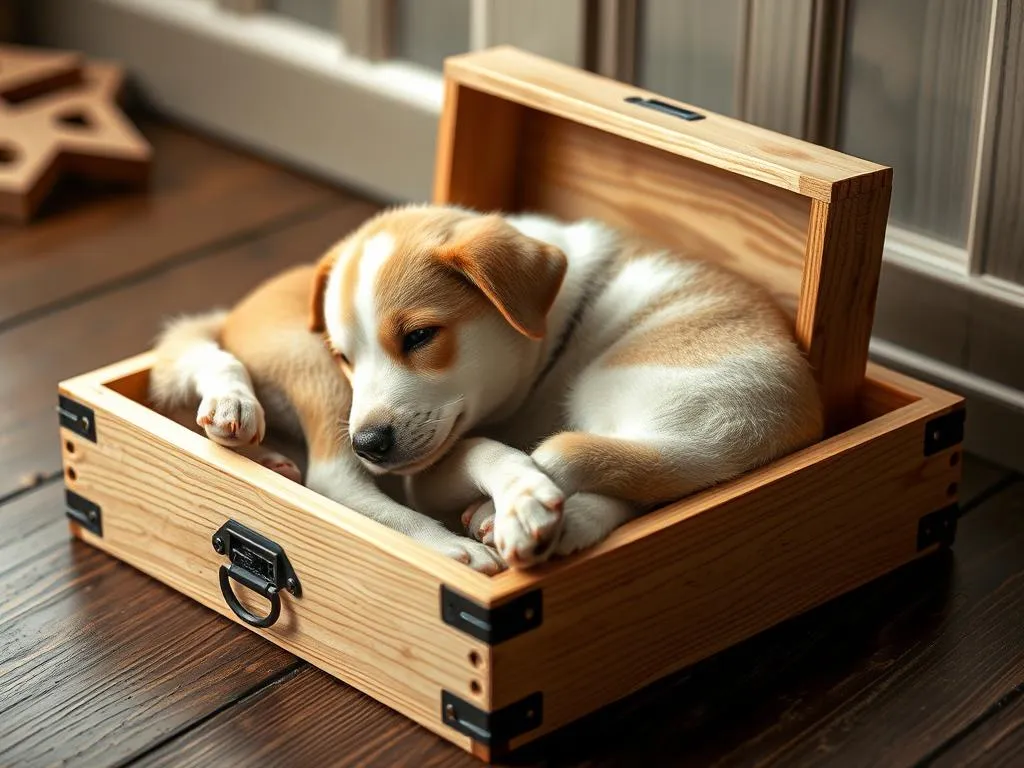
Introduction
A whelping box is an essential tool for dog breeders, designed to provide a safe, comfortable environment for a mother dog during the birthing process. This enclosed space not only protects the puppies but also offers the mother a place to feel secure and nurture her young. The importance of a properly constructed whelping box cannot be overstated; it reduces stress for the mother, facilitates the birthing process, and creates a controlled environment for the puppies during their vulnerable early days.
Building a DIY whelping box is not only cost-effective but also allows for customization to meet the specific needs of the mother and her litter. With the right materials and guidance, you can create a space tailored to your dog’s size, breed, and preferences, enhancing the overall whelping experience. In this article, we will explore the fundamentals of a whelping box, guide you through the planning and building process, and provide tips for maintaining it after use.
Understanding the Basics of Whelping Boxes
What is a Whelping Box?
A whelping box serves as a designated area where a dog can give birth and care for her puppies. Typically, it is a sturdy, enclosed space that provides privacy and security, reducing the risk of the puppies being harmed or lost. While commercial options are available, many breeders prefer a DIY whelping box due to the flexibility it offers in terms of size and design.
Benefits of a Whelping Box
The benefits of utilizing a whelping box extend to both the mother and her puppies:
- Safety for Puppies and Mother: A well-constructed whelping box minimizes the risk of accidental injury during the birthing process, ensuring that the puppies remain safe and secure.
- Easier Management of the Birthing Process: Having a defined space allows breeders to monitor the mother closely and intervene if necessary, providing assistance during the birthing process.
- Comfort and Privacy: A whelping box provides a private area for the mother dog, allowing her to focus on birthing and caring for her puppies without distractions.
Key Features to Consider
When planning your DIY whelping box, consider the following features to ensure it meets the needs of both the mother and her puppies:
- Size Dimensions Based on Dog Breed: The box should be large enough for the mother to lie down comfortably and for the puppies to move around. Generally, a size of about 36 inches by 24 inches is suitable for medium breeds, while larger breeds may require a box measuring 48 inches by 36 inches or more.
- Materials Suitable for Hygiene and Durability: Use non-toxic, easy-to-clean materials. Plywood or melamine board is recommended for the walls, as they are durable and resistant to moisture.
- Accessibility for the Mother and Puppies: Consider creating a low entry point for the mother to easily enter and exit, as well as ensuring that the puppies can access the milk supply easily.
Planning Your DIY Whelping Box
Choosing the Right Location
Selecting the ideal location for your whelping box is crucial for the comfort and safety of the mother and her puppies. Look for a quiet, clean, and warm space where the mother can feel at ease. Basements, spare rooms, or utility rooms can be excellent choices, as they often provide the seclusion needed during this sensitive time.
Materials Needed
Gather the following materials to construct your DIY whelping box:
- Wood: Plywood sheets (1/2 inch thick) for the sides and bottom.
- Screws: To secure the corners and add stability.
- Non-toxic Paint or Sealant: To finish the wood and protect it from moisture.
- Washable Bedding: Soft bedding, such as fleece or blankets, for added comfort.
- Optional Accessories: Heat lamps or heating pads to maintain an optimal temperature for the puppies.
Tools Required
You will need the following tools for the construction of your whelping box:
- Saw: A circular saw or hand saw for cutting the wood.
- Drill: To make holes for screws and secure the pieces together.
- Measuring Tape: For accurate measurements.
- Safety Equipment: Gloves and goggles to protect yourself while working.
Step-by-Step Guide to Building a DIY Whelping Box
Measuring and Cutting the Materials
Start by measuring the dimensions of your DIY whelping box based on the size of your dog. Here’s a step-by-step process:
- Measure the Height: The box should be about 24 inches tall to prevent puppies from escaping while allowing the mother easy access.
- Cut the Base: Cut a piece of plywood for the bottom that fits your desired dimensions.
- Cut the Sides: Cut four pieces of plywood for the sides, ensuring they are the same height as the base.
Assembling the Box
Once the materials are cut, follow these steps to assemble the box:
- Attach the Sides to the Base: Using screws, attach the cut plywood sides to the base, ensuring they are flush and secure.
- Reinforce the Corners: For added stability, consider adding corner brackets or additional screws in the corners.
Creating Entry and Exit Points
Creating a safe entry point for the mother dog is essential. Follow these instructions:
- Cut a Low Entry: On one side of the box, cut a low entrance approximately 8 inches from the ground to allow the mother easy access.
- Smooth Edges: Sand down any rough edges to prevent injuries.
Adding Comfort and Safety Features
To make the whelping box more comfortable and safe:
- Choose Soft Bedding: Line the bottom of the box with soft, washable bedding to provide comfort for the mother and her puppies.
- Consider a Heat Source: If necessary, utilize a heat lamp positioned outside the box to maintain an appropriate temperature for the puppies, especially in cooler environments.
Preparing the Whelping Box for Use
Cleaning and Sanitizing
Before introducing the mother to the whelping box, it is essential to clean and sanitize it thoroughly.
- Use Mild Detergent and Water: Clean all surfaces with a mild detergent to remove any dust or residues.
- Sanitize: After cleaning, use a pet-safe disinfectant to sanitize the box.
Setting Up the Environment
Creating a comfortable environment is crucial for the mother dog:
- Temperature Control: Maintain a temperature of around 75°F to 80°F in the room where the box is located.
- Ventilation: Ensure there is adequate ventilation to keep the air fresh and prevent overheating.
Introducing the Mother Dog
When introducing the mother dog to the whelping box, consider the following strategies:
- Encourage Exploration: Allow her to explore the box at her own pace, using treats or toys to encourage her.
- Monitor Behavior: Keep a close eye on her behavior to ensure she feels secure and comfortable in her new environment.
Post-Whelping Box Care and Maintenance
Cleaning After Whelping
Once the puppies have arrived, maintaining cleanliness is vital:
- Remove Soiled Bedding: Immediately remove any soiled bedding and replace it with fresh, clean material.
- Regular Cleaning Schedule: Establish a cleaning routine to ensure the box remains hygienic during the puppies’ early weeks.
Transitioning Puppies
As the puppies grow, you may need to transition them to the next stage:
- Timing: Begin transitioning them around 4-5 weeks when they start exploring their surroundings.
- Puppy-Proofing: Ensure the area outside the whelping box is safe and secure, removing any hazards.
Repair and Reuse
After the whelping process, consider how to repurpose the whelping box for future litters:
- Repurposing Ideas: The box can be used for storage, as a dog playpen, or adapted for other small animals.
- Maintenance Tips: Inspect the box for any wear and tear, making necessary repairs before the next use.
Frequently Asked Questions (FAQs)
Common Concerns About DIY Whelping Boxes
Many breeders have questions or concerns regarding DIY whelping boxes. Here are some common topics:
- Durability: Will a DIY box hold up during the birthing process? Yes, if constructed properly with quality materials.
- Size Adjustments: What if I have a large breed dog? Customize the dimensions to accommodate the breed’s size for optimal comfort.
Alternatives to DIY
While DIY whelping boxes offer customization and cost savings, some may choose commercial options. Here’s a brief overview:
- Pros of Commercial Options: Convenience, professional design, and often built-in features.
- Cons: Higher cost and limited customization.
Conclusion
The construction of a DIY whelping box is a rewarding project that can significantly enhance the birthing experience for both the mother dog and her puppies. By understanding the basics, planning carefully, and following our comprehensive guide, you can create a safe, comfortable environment tailored to your dog’s needs. Embracing this DIY approach not only saves you money but also allows you to take pride in providing the best care possible for your furry friends. Happy building!









